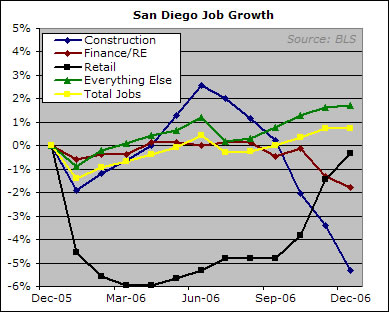The positive job growth to which I alluded in the prior entry just got a little less positive.
Last month, I noted that November losses in the housing boom beneficiary sectors — construction, retail, and finance/real estate — were acting as a drag on what would otherwise have been fairly robust overall employment growth. The same pattern presented itself in December even more noticably.


I think the story at this
I think the story at this link indicates something big is about to happen, and it’s not good.
http://tinyurl.com/2buqcv
The first three sentences in the second paragraph should be a wake-up call to many builders.
Rich, what significance, if any, would you give this? Am I reading more into this than I should? The rate they cite still seems low. I know everything is relative, but to deviate from a 50-year norm seems to me indicative of something bigger going on in just below the surface of the economy.
I think you’re right, that
I think you’re right, that it’s something to be concerned about, sdb1. The vacancy rate in the West is now at its all-time highest in the data series, originating from 1956.
Here’s an earlier thread on vacancy rates:
http://piggington.com/vacancy_rate_in_the_west
Yep, it’s going to be a fun 5-10 years.
January 19, 2007
4Q06
January 19, 2007
4Q06 SUMMARY
Quarterly Occupancy Declines Notable in Every Market
Fourth quarter survey results revealed occupancy declines in every major MSA tracked, according to data released today by RealFacts. Even allowing for seasonal adjustments to occupancy the declines in every MSA, with several exceeding 3%, indicate a reaction to rent increases that started earlier in the year. Such wide spread declines in occupancy likely herald reductions in rent growth rates. For example, after years of strong rent growth, including a 7.4% annual rate at the end of 2005, Riverside-San Bernardino-Ontario MSA occupancy fell 3.9% this quarter with annual rent growth sliding to 4.9%.
During the fourth quarter occupancy declines occurred in every market tracked. Four MSAs exceeded a 3% decline, 6 markets declined between 2% and 3%, 15 between 1% and 2%, and 4 declined less than 1%. A year ago only one market declined more than 3%, 2 were between 2% and 3%, 5 were between 1% and 2%, and 14 were less than 1%, while 6 markets showed occupancy gains. Colorado Springs MSA was the lowest again at 89.3%, while San Jose-Sunnyvale-Santa Clara was highest at 96.2%. The whole database registered a 1.4% decline for the quarter, and 0.2% decline for the year.
Annual rent growth rates continued to strengthen across the whole database, as several markets leap- frogged their way over some that showed declines. San Jose MSA lead the way at 11.5% annual rent growth, strongly up from 3.5% a year ago. Oxnard-Thousand Oaks-Ventura and Seattle followed at 8.8% and 8.3% respectively, while Riverside-San Bernardino and Las Vegas fell below 5% annual rent growth to 4.9% and 4.6%. Salt Lake City and Tucson joined the 5% plus club at 5% and 5.3%. Portland OR continued to gain, up to 6.3% from 1.5% a year ago as Phoenix held steady at 5.5% from 5.1% a year ago. As individual markets shifted up and down, the overall picture continued to show gains with 9 markets above 5% annual growth at the end of 2006, up from 4 the previous year. The whole database registered 0.8% quarterly rent growth and 4.2% annual rent growth, up from 3.3% annual growth at the end of 2005.
Several mid-west markets started to heat up, registering strong growth from a year ago: Kansas City MSA recorded 2.7% annual rent growth this year, up from 0.7% last year, Oklahoma City is up to 3% from 0.4%, Saint Louis is up to 2.5% from 0.7% and lagging behind, but still showing gains, is Indianapolis up to 1.9% from 0.6%. Texas MSAs recorded mixed annual rent growth results with Houston-Baytown-Sugar Land down to 1.8% from 3.4% a year ago, Dallas-Ft Worth-Arlington down slightly at 0.1% from 1.1%, Austin-Round Rock showed modest gains at 2.4% from 0.8%, and San Antonio with strong growth up to 4% from 0.4% a year ago.
Average sale price per unit of apartment communities in the RealFacts database fell in 2006 to $101,195. The decline from the 2005 high of $109,372 is likely due to the slow down in the red-hot condo conversion market that drove prices up as owners cashed in on lucrative conversions. RealFacts recorded 540 transactions for 2006, with more to come as year end sales close.
Caroline Latham
CEO
RealFacts